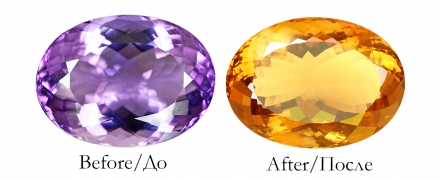open 10 am - 7 pm
laboratory is closed
How and why stones are baked

A wide range of stones used in the jewelry industry is subjected to heat treatment. The main purpose of such processing is to change the color of the stone to a brighter or more saturated one. The most common heat-treated stones are corundum, garnet, beryl, tourmaline, and quartz varieties. Each type of stone has its own conditions that contribute to the color change after heating. For example, if corundums and garnets are heated to at least 600 ° C to change color, then beryls, tourmalines and some varieties of quartz change color at much lower heating.
In general, heating stones to relatively low temperatures (up to 350 ° C) in order to change their color has been used for a long time. Let's consider this method using the example of quartz of different colors. So morions (black and almost black quartz) were carefully heated, baked in a bread loaf. As a result, the dark shades disappeared, and the stone acquired a tea-golden hue. The smoky color of some rauchtopazes disappears when heated up to 300 ° C, which also refers to the radiation citrine and amethyst colors, which begin to lighten already when heated from 150-200 ° C. When heated above 400 ° C, the color of amethyst with purple changes irreversibly to yellow-orange citrine. And some amethysts from deposits in Brazil and Uruguay, when heated to temperatures of about 500 ° C, acquire a beautiful green color. These stones are called "praseolite" in the trade.
В геммологической практике бывают весьма увлекательные случаи с диагностикой ювелирных вставок
Но помимо редкости цвета и высокой стоимости таких камней, многие розовые камни выделяются одной замечательной особенностью – они проявляют плеохроизм, то есть в зависимости от положения осмотра камня он может иметь дополнительные оттенки – оранжевый или пурпурный.
Currently, gemstones are produced by two fundamentally different technological methods - the High Pressure - High Temperature method (“HPHT”, High-pressure & High-temperature) and the Chemical Vapor Deposition (“CVD”, Chemical vapor deposition) method. The "HPHT" method is the most tested classical synthesis method, which can be used both carbon deposition on diamond from flux melts and catalytic reactions. In "CVD" synthesis, diamond growth occurs on a seed during carbon deposition mainly from a gaseous medium at relatively low temperatures and pressures.
Jewelry and precious stones are just such a category of goods, when buying which you need to pay attention to many criteria.
Sogdianite is a rather rare mineral and more often it can be found as a collection material (moreover, in systematic collections), and it is extremely rare in jewelry.






